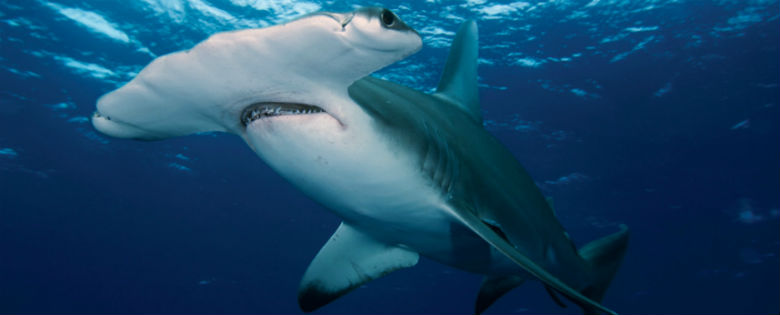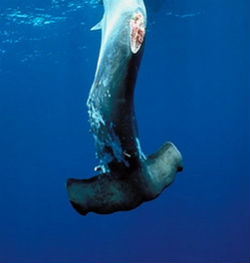Federal fisheries managers have proposed adding four populations of scalloped hammerhead sharks to the Endangered Species List, but the proposal doesn’t include hammerheads off the Southeast coast despite dramatic declines in their population.
The listing proposal from the National Oceanic and Atmospheric Administration’s National Marine Fisheries Service recommends listing hammerhead populations in the far eastern Atlantic Ocean and along the U.S. West Coast as “endangered,” the highest classification under the federal Endangered Species Act. Sharks in the central and southwest Atlantic and those in the western Pacific and Indian oceans would be listed as “threatened,” which comes with fewer restrictions.
Supporter Spotlight
Want to Comment?NOAA is still seeking comments from the public on the proposed listing of After publishing a proposed rule, NOAA’s fisheries service considers the Public comments maybe submitted via the Federal |
Hammerhead populations along the Southeast coast have declined by more than 80 percent and by as much as 98 percent off the N.C. coast since the 1970s, the fisheries service notes in its assessment report. Despite those grim statistics, the remaining fish in those waters won’t get federal protection.
“Although these declines in former abundance numbers are significant,” the service concludes in its report, “the latest stock assessment… found that population numbers have remained fairly stable since 1995.”
Better state and federal management programs should lead to a slow recovery of hammerheads along the Southeast coast within the next 30 years without adding hammerheads in the region to the endangered species list, the report notes. For example, in the U.S. Atlantic, the species is managed under a fishery management plan, with established biological catch levels to control harvest.
Supporter Spotlight
The service is also finalizing an amendment to that plan establishing a rebuilding strategy for hammerhead shark stocks and implementing regulations for U.S. shark fisheries in the Atlantic Ocean, the Gulf of Mexico and the Caribbean.
Taylor Jones, endangered species advocate for WildEarth Guardians conceded that “we’re a little disappointed” that the listing proposal doesn’t include all hammerheads.
Jones’ group, which is based in Santa Fe, N.M, and Friends of Animals petitioned the federal government in August 2011 to add the sharks to the list. If finalized, the listing would prohibit imports, exports and commercial activities dealing in the species from the affected regions.
“These ‘wolves of the sea’ need our protection,” Jones said. “For most of the United States, this isn’t going to change much.”
But, she added, the fisheries service is to be “commended for the thoroughness of its research and its findings.”
Protection for any of these fish can’t be bad, said Paul Barrington, a shark expert who is director of husbandry and operations at the N.C. Aquarium in Fort Fisher. The proposed listing, he noted, is part of an ongoing effort to protect many sharks, which have long been under pressure, in large part because their fins are prized by consumers in the Orient.
Hammerhead sharks (Sphyrna lewini) are among the largest sharks and are found throughout the world. They usually weigh more than 1,000 pounds and often measure longer than 14 feet when fully mature.
“We see them pretty frequently in North Carolina waters offshore, a few times a year; I come across them myself sometimes in my fishing adventures,” Barrington said. “We also see some smaller ones inshore, occasionally. Most of the pressure on these sharks now comes from countries that, I would say, don’t pay all that much attention to our Endangered Species Act sometimes, but whatever we can do to help is probably good.”
Even if hammerheads off N.C. waters were included in the proposed listing, the state’s commercial fishermen would have hardly noticed. There is little or no directed commercial shark fishery in the state because regulations have been tightened significantly in recent years. Randy Gregory, a biologist who handles most shark issues for the N.C. Division of Marine Fisheries, said there are only a handful of fishermen in the state who directly target sharks, down from 20 or so a decade or so ago. Hammerheads are rarely taken, he said.

“It (shark fishing in the state) pretty much ended 10 years or so ago,” Gregory said. “The season doesn’t open until July, and it’s not open long. They (permit-holders) can only take 33. There is more on the Gulf (of Mexico), and there is some bycatch in the king mackerel fishery, but not much. The days where you’d see people putting out bottom longlines for sharks are pretty much gone.
The listing proposal cites threats from overfishing and inadequate management of foreign fisheries, with illegal, unreported and unregulated fishing, as significant problems.
“Sharks are a valuable part of our ocean ecosystems, and the sharks we are proposing to list under the Endangered Species Act are in trouble,” Sam Rauch, assistant NOAA administrator for fisheries, said when the agency announced the listing proposal a few weeks ago. “Sharks worldwide face a number of threats, and these sharks in particular, are facing threats from inadequate worldwide fisheries management to poaching for their fins.”
NOAA’s Fisheries Service will designate critical habitat for the listed populations of scalloped hammerheads that occur in U.S. waters if it is determined to be prudent.
The hammerhead has an elongated, flattened head, which on the scalloped hammerhead has distinctive, curved indentations along the front edge. Most sharks, including scalloped hammerheads, play an important role as top predators in maintaining ocean bio-communities, according to NOAA. The agency says ecosystem stability and biodiversity, which are congressional priorities for the Endangered Species Act, could seriously suffer from the loss of these top predators.
Barrington noted that the hammerheads are near the top of the food chain, seriously threatened – only by man, killer whales and a few exceptionally large white sharks.
 The carcass of a hammerhead shark, its fins cut off for shark fin soup, sinks to the bottom. |
The larger sharks, he agreed, play a key role in aquatic life. And while some people bristle at the mere suggestion of protecting sharks, largely because of publicity after shark attacks on humans, Barrington said it’s necessary both biologically and morally.
To people who say why bother, he asked, “Well then, why bother to protect any living animal on the planet? They (sharks) have been here far longer than we have,” he said. “If you’re going to go that route, why protect dogs? There have probably been more dog attacks on humans in the five minutes we’ve been talking than there are shark attacks every year.”
Jones, like Barrington, dismissed the ideas that because many countries don’t try to fully enforce U.S. laws, the listing isn’t worth doing it at all.
“We do realize that occurs, and that law enforcement in some cases doesn’t have the resources it would like to have,” she said. “But to say it doesn’t do any good because of that … that’s self-defeating. If you’re going to have that kind of attitude, well, why have any laws at all? We do think they (NOAA) are very committed to doing the best they can. And just the provision to ban imports of shark products is very important.”
Jones said she and the organization prefer to view the action in a positive light, especially since it’s been hard, historically, to get NOAA to list any marine species.
“We will be taking a look (at hammerhead populations) not proposed for listing, just to make sure there’s nothing that was missed, but we’re happy to see some movement on the hammerhead and on sharks in general,” she said. “They (hammerheads) are a really important top predator, and marine species in general have been underserved (by the ESA). Most of life on earth is in the ocean, and we’re pleased to see this start.”
The petitioners said the biggest threat to scalloped hammerheads is fishing, both through direct and accidental capture. Scalloped hammerhead sharks have very high commercial value. They are especially coveted for their fins, which are used in dishes such as shark-fin soup. In finning, crews land the sharks and remove only the fins, then throw the sharks back, disabled and sure to drown or die of starvation.
To a lesser extent, the shark’s flesh is also sold in various forms as food or fish meal, and the oil is used in vitamins.
The commercial value of the species, combined with the shark’s’ slow rate of reproduction, makes them highly vulnerable to exploitation.
According to the Marine BioConservation Society, hammerheads reproduce only about once every two years and the gestation period is one year. While young ones sometimes travel in large schools, adults often are found in pairs. They eat fish, squid, octopus, shellfish and smaller sharks.
Lee Hall, vice president of legal affairs for New York-based Friends of Animals, said in a recent news release that, “Shark exploitation must be confronted if scalloped hammerheads and other sharks are to survive and thrive.”
The Whitley Fund for Nature estimates that up to 100 million sharks are killed each year worldwide. The International Union for Conservation of Nature estimates the hammerhead population has declined by as much as 80 percent in the past 25 years.
And, Hall said in the release, listing species under the Endangered Species Act has proven an effective safety mechanism: more than 99 percent of plants and animals listed under the Act persist today.








